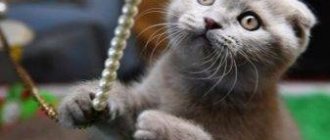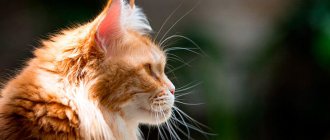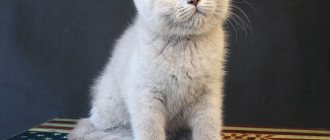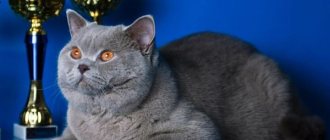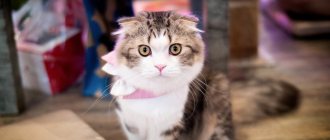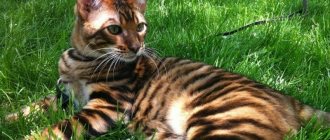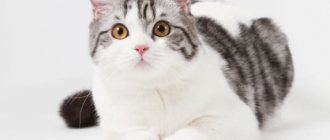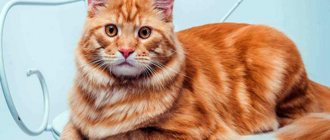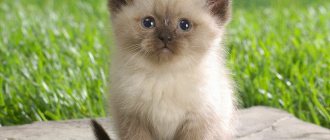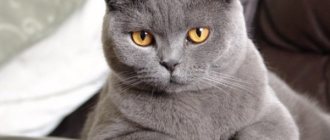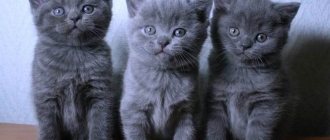Scottish Blue Point cats
The color of blue point Scottish cats (translated from English as “blue-point” means “blue dot”) is very beautiful. These are completely unique shades of light fur - the main color and shading on the paws, muzzle, ears and tail. Many people want to get just such a cat, because she is fabulously cute.
The blue point color is associated with the phenomenon of acromelanism - the dependence of the intensity of coat coloring on temperature: in places where the body temperature is higher, the coat is lighter, and vice versa. While colorful kittens are in the mother’s belly, they are completely light, because their body temperature is uniform. But within a few days after birth, Scottish Blue Point kittens begin to darken their paws, tail, face and ears due to the fact that the temperature of these parts of the body is lower than the rest. This effect is associated with the action of the enzyme tyrosinase, which is responsible for the synthesis of pigments. By the way, for the same reason, colorful cats can change color slightly depending on the air temperature - sometimes darker, sometimes lighter. In addition, this color changes with age.
The color gene in cats determines not only the color of the coat, but also the eyes, which remain blue without changing to golden in adulthood. Blue eyes are the dream of almost every cat owner. And the main thing is that in this case the blue-eyed gene is not associated with deafness, as happens in pure white murkies. As a result, we have unique shades of eyes and fur, which, as a rule, are liked by absolutely everyone, even those who can’t stand Chocleate Point cats (“chocolate point”), which are associated with Siamese and create the impression that they stuck their muzzle in chocolate.
Features of the Blue Point color in the British
When people mention the British, people most often imagine a blue (gray) cat. In fact, there are a lot of possible color options. These are solid, bicolor, particolor and tricolor (tortoiseshell), tabby, shaded, smoke and even color point. The colors are named after the color of their markings.
Colors with markings are a distinctive feature of Siamese and Thai cats. However, not only they can become carriers of an unusual fur coat.
Point colors are the hallmark of the Siamese and Thai breeds. This coloring is sometimes also called Himalayan. It is formed due to a special mutation of the gene responsible for coloring. Therefore, in “cold” areas, where the body temperature is slightly lower - paws, head, tail, ears - the coloring is noticeable. And the color of the fur on the body is close to white. There the pigment hardly shows itself. For markings of a dark color - seal point - pale cream or ivory coat is acceptable.
Accumulations of pigment in certain areas are called marks, points or dots. And the color itself of this type is color-point, or simply point.
The gene responsible for the point color is recessive. To give birth to a kitten with markings, both parents must be carriers of such a gene. This is the difficulty of breeding British Pointers - most representatives of the breed do not possess such a gene. When mating with Thai cats, it is very difficult to preserve other breed characteristics:
- large bones;
- cheeks;
- printed wool;
- phlegmatic character.
The eye color of pointing cats is usually blue or blue, like Thai cats. Only smoky, silver, shaded or chinchillas have turquoise and even green irises.
The main body color is light, from a cool white tint to a pale gray-blue. The markings should be a uniform blue hue, without stripes or spots.
Blue is a fairly light color, so it is important for breeders to achieve a good contrast between the body and points. Blue Points have blue or blue eyes.
They should also stand out in contrast on the face. The nose and paw pads of animals are uniformly gray-blue in color.
Blue Points have blue or blue eyes. They should also stand out in contrast on the face. The nose and paw pads of the animals are a uniform gray-blue color.
Like other points, blue points darken with age, the color becomes more pronounced and intense.
It is extremely important that the body itself does not turn blue-gray. Such a cat will no longer be allowed to enter the exhibition.
In the matter of preserving color, housing conditions play an important role. In cold rooms, animals quickly acquire dark pigmentation throughout their body. In the heat, even the markings on the paws and tail can lighten.
Seal tabby point is another popular color among British and Thai cats. The tabby point is a classic striped color, characterized by the letter “M” on the animal’s forehead.
The British Blue Point differs from the Thai Seal Tabby Point cat breed mainly in its physique. The British are larger, stronger, with a rounded body. Thais reach medium size and are more graceful.
The table shows the characteristics of the British Blue Point and the Thai Seal Tabby Point breed according to the main characteristics:
Blue point color standard
A straight-eared or fold-eared Blue Point Scottish cat should have a blue mask on its face and the same markings on its ears, paws and tail. The rest of the body is almost white: without markings or patterns, blurred spots and yellow tones. All this is considered a disadvantage.
A good point color that will last a lifetime is quite difficult to obtain. Small kittens often have high-quality coloring that matches the standard, but as they grow older, the body may darken, which is a big disadvantage.
The ideal point color works well when both parents of the kitten are also points, and not in the first generation. Conversely, there is a greater chance of getting a darkened body if the parents were of a different color, for example, solid (solid).
The eyes of a blue point cat, as we have already said, are blue. The darker, more saturated, “deeper” the color, the better. Cats with light eyes (and often they are not at all expressed, grayish) are valued less.
Colories with decent eye color often have disgusting coat texture and a rustic appearance. The British often have weak bones, the Scots have short, problematic tails and ears that are not laid back well enough. These disadvantages are related to similar problems with shaded colors, which are most often used to produce color points. Yes, there are already some British people with decent hair and decent type, but there are only a few of them. As well as in the colorful colors worthy of the Scottish ones, there are only a few. British colors, obtained from blue, lilac, and patterned animals, most often have good bone and coat. In some places there is even a good contrast, but for the most part they have an extremely pale eye color. Scottish breeds bred from colored stock are also pale-eyed. They have a positive chance only if they are obtained from stable lines imported at different times from the USA and Canada. Local stock bred from the British will produce British-like variants with all the characteristic nuances.
Similar breeds
The first description of cats with unusual folded ears can be found in the Chinese World Journal of Knowledge and Entertainment, dated 1796. Of course, these were not Scottish Folds, these were ordinary domestic cats that were carriers of the defective gene.
The ancestor of the breed was the white cat Susie with unusual ears, which was noticed in 1959 by Scottish farmer William Ross. He became interested in the unusual animal and in 1961 purchased her fold-eared kitten from Susie’s owner. This is how the history of purposeful breeding of original cats began, which eventually became a separate breed.
Recognition of the breed was not easy. In England the breed was recognized, but then its breeding was banned. This is all due to a mutant gene that causes many diseases in cats of this breed. In 1978, the breed began to be bred in the USA. Today, the Scottish Fold breed is recognized by the Cat Fanciers Association (CFA), the World Cat Federation (WCF), and the International Cat Association (TICA).
If you want a kitten similar to the Scottish Fold, take a look at the Scottish Straight British Shorthair or the Chartreuse breed. Of course, they do not have such charming ears, but in character, quality and coat color they are so similar to the Scottish Fold.
Coloring with blue markings is typical for many feline breeds.
First of all, these are Siamese cats, which became the progenitors of blue markings. The second most popular are representatives of British and Scottish breeds.
READ What to do if your cat is going bald at the tail
Blue point color genetics
Point belongs to the black series of colors, because, from the point of view of genetics, blue is nothing more than a diluted, or rather rearranged, black pigment. But blue coat genes B (black series) and d (dilution gene) alone are not enough to get a point kitten. A couple more recessive cs genes are needed, which displace the pigment into the marking area.
The ancestors of the Points are Siamese cats, which is why the color is also called Siamese. In Thailand it is considered sacred because... he was taken out by the monks in the monastery.
Today, among Scottish cats, the color gene cannot be called so rare, but breeders often value its carriers higher than solid blue cats. There are even entire nurseries that specialize in the reproduction of Point cats.
You can get a point cat even if both parents, for example, are gray (that’s what people call them, although they are actually blue). The main thing is that they are carriers of the desired gene. But even if they carry this gene, the chance of having a colored kitten is 25%. It happens that the color gene appears after 2-3 generations. For example, the kitten’s great-grandparents were colorful, but the gene did not manifest itself in the form of color in the parents. At the same time, two color point parents cannot produce a kitten of a color other than color point.
The international designation for the blue point color is a33.
Color point Scottish cat
The color-point color of a Scottish cat in America is called “Himalayan,” but here in Russia this color is widely known as “Siamese.”
A distinctive feature of the colors of this group is the dark tone of the protruding parts of the cat’s body, namely: the muzzle, ears, tail and paws (the so-called “points”) and the light color of the animal’s body.
What are the distinctive features of such an unusual color point color?
The color of the points on the coat of a Scottish cat depends on the original color of the cat and can be either one of the solid colors or a variant of “tabby” or, as they sometimes say, “lynx” - bear a pattern or even be tortoiseshell.
Thus, the color of a black Scottish cat with a pair of color genes will be called Seal-point (Seal-point SFS n 33), that is, the fur on the protruding areas of the body (points) will have a dark brown tint.
The eye color of a Scottish color-point cat should be blue, and the richer the tone, the better. There are Scottish Fold and Straight-eared cats with literally sapphire eye color, which is very rare!
It is also important to know that:
- Two color point parents cannot produce a non-color point kitten
- It is possible to get a Scottish Siamese kitten only if both parents are carriers of the color point color (even if they themselves are solid color). If a Scottish couple of a male cat and a female cat have a color point color, then in this case they each pass on one color gene to their offspring. As a result, all kittens will have the same set of genes. Then the conclusion follows that from a cat and a cat of a “Siamese” color, kittens of ONLY this color are born.
- If a Scottish Fold cat of color point color gives birth to at least one color from a solid color cat, this means that the cat is a CARRIER of the color point color gene. There is an equal probability of having kittens of solid and point color, but sometimes it happens that, for example, from such a pair of parents all the kittens of one litter will be solid color, and from another litter from the same pair all kittens will be color-point.
- If a Scottish cat of non-color point color bred with a cat of non-point color, but one of their kittens was still born with color, then it follows that both parents are CARRIERS of the color gene.
- Parents who are not color point carriers will NEVER produce Scottish Siamese kittens, since their genes do not contain this color.
At birth, Scottish kittens are very close to white in color, but over time the points begin to become colored. In the first month, the color of the ears and tails is formed. The color of the face develops slowly, and in some cases the color fully “flourishes” only by two years.
The contrast of the points is very important; they must have clearly visible boundaries, and the cat's body must be much lighter than the points.
Sometimes some darkening of the cat’s body is not considered a drawback, but, of course, the absence of dark spots on the belly is also important
Scottish cats of colorful colors are incredibly beautiful!
Solid color point colors
The points must have the same tone, without any pattern or white spots.
SEAL-POINT SFS N 33
The shade of poins is dark brown, and the body of the animal has a lighter cream color.
CREAM-POINT SFS E 33
The points are cream in color and the body is a light cream tone.
Tortoiseshell color-point colors
SEAL-TORTIE-POINT SFS F 33
The seal point color has red spots, while the body color of the Scottish Fold cat is predominantly light cream.
LILAC-TORTIE-POINT SFS H 33
Lilac point markings are characterized by cream spots; the body has a light cream tint.
Tabby (Lynx)-point colors
A characteristic feature of these colors is the presence of clear stripes on the muzzle, tail and paws. On the cat's front paws, there are predominantly torn rings running from the toes upward. There are stripes on the thighs and a solid shade on the hind legs down to the hocks. The ears of a Scottish Lynx Point cat are characterized by a solid color.
SEAL-TABBY-POINT SFS n 33 21
The color of the points is dark brown, located on a light brown agouti background. The body has a light cream color. The nose mirror is dark in tone, and there is a red spot around it.
Strabismus in point cats
Cats of any point color (and there are not only blue, but also seal point, lilac point, lynx point and other variations) can experience convergent strabismus, which is characteristic of cats of the Siamese, Thai, Oriental and Burmese breeds. This defect, geneticists believe, is a byproduct of the action of the cs point gene.
Often in point cats you can find a violation of the projection of the optic nerves: part of the visual pathways from the eye goes to the side of the brain opposite to the norm. To compensate for this feature, strabismus appears, which allows the cat to build the correct visual picture.
However, there is an opinion that just one pair of cscs genes is not enough for the development of strabismus: additional genes are needed that lead to such a disorder. That is, to say that most point cats suffer from strabismus is incorrect: the majority of Scots point cats, in fact, do not have this problem.
Breeding and nurseries
The Scottish Straight cat breed is popular in many countries around the world, although straights are usually considered secondary in the Scottish breed, where all attention is focused on folds. For the same reason, straights are slightly cheaper than their fold-eared counterparts
In order to improve the breed, American Shorthair and British breeds are allowed to breed Scottish. The presence of impurities in kittens can be seen in the pedigree.
There are two directions of Scottish breeding - American and European. American breeders are ahead of their European colleagues in the quality of offspring obtained, including thanks to special breeding programs.
The Scottish Straight breed is very common all over the world, including in Russia. Scottish cat breeders can be found in almost any major city. Each of the nurseries has its own goals and objectives when conducting breeding work. When contacting a nursery, you need to understand what type of animals the nursery develops and what line is leading. Information about catteries and the breed can be obtained by visiting cat shows, or by contacting a club in your city.
Some nurseries:
Blue point color and character
There is an opinion (not a proven fact) that the Blue Point Scotsman is a cat with character. The fact is that the blue colors of the Scots were originally obtained from British cats, known for their temper. Modern Scottish Folds and Blue Point Scottish Straights are somewhat similar in character to the British: they are independent, willful, and can be aggressive if they don’t like something. However, the degree of expression of these qualities depends on the presence of British cats in the immediate family. If there are a lot of British people in the document, you should expect a tougher character, and vice versa. However, British genes will still be softened by Scottish ones, so such cats are more sociable and kinder than their British counterparts.
Requirements for maintenance and nutrition
The character of the Scottish Fold cat is calm, imposing and lazy by nature. They require little space and time from the owner. However, there is a serious “but” in this characteristic - childhood and adolescence. During this period, the kitten is a perpetual motion machine with inexhaustible energy and imagination, for whose arrival the apartment must be prepared.
- Remove unnecessary items. Electrical wires, cables, charging gadgets, breakable things, as well as small objects that a kitten can swallow.
- Buy utensils for food and water. Use heavy ceramic or metal bowls to prevent your kitten from tipping them over.
- Buy a tray and filler. Decide where the cat will have a toilet, and from the first hour accustom him to one place. For a baby, a tray with low sides is better, but over time it will have to be replaced with a model with higher sides.
- Prepare your sleeping area. A special bed, house or folded blanket. The cat may get used to sleeping “at home”, or he may refuse to have his own place, but after the stress of moving, the kitten will most likely like his own independent cozy corner.
- Buy a carrier. Necessary for preventative visits to the veterinarian and travel.
- Buy a scratching post. It is necessary to accustom a cat to it from childhood so that it does not sharpen its claws on furniture and walls.
- Stock up on toys. A young Scot needs to be entertained and distracted from petty hooliganism, so the toys can be varied.
From the very first days, a Scottish kitten is taught to eat and use a toilet.
It is important to ensure that your pet only eats from a bowl, otherwise pieces of his food will end up on the carpet or sofa.
Often, a kitten is litter trained from the breeder under the mentorship of its mother cat. To ensure that the skill is immediately evident in your new home, take a sample of the smell and mark the new tray with it. In the first days, keep an eye on your pet if possible, and as soon as he starts fussing, take him to the tray. If something goes wrong, remove any traces of odor from the floor, otherwise the animal may think that the toilet is there.
Otherwise, caring for Scottish Folds is accessible even to inexperienced and very busy people. The main actions and their approximate frequency are described in the table.
Table - Caring for a Scottish Fold cat
| What to do | Frequency | Adviсe |
| Comb | - Once a week; - during molting - every day | - Use a special brush with non-sharp teeth; - additionally comb the long-haired subspecies with a comb |
| Bathe | Semiannually | — Make sure that no moisture gets into your ears; dry the coat and undercoat well |
| Trim claws | Once every 2-3 weeks | Use special pruning shears not close to the base |
| Clean ears | Once every 10-14 days | - Use a cotton swab (a swab can damage your ear); - if there is purulent discharge with a characteristic odor - contact a specialist |
| Examine your eyes | Daily | - Wipe with a cotton pad; - consult a veterinarian if the eyes are watery for a long time, there is purulent discharge, unpleasant color and odor |
| Treat for worms | 2 times per year | Follow the time limits for re-treatment according to the instructions for the drug. |
| Treat for fleas | At the beginning of the warm season | |
| cut | Optional or to prevent overheating | - Use only the services of professionals; - for exhibitions, do a minimal haircut to emphasize the roundness of the shape; - in hot weather, cut more intensely |
If a cat walks outside, the claws wear down naturally, so there is no need to trim the claws.
Diet
The peculiarities of their structure and coat make Scottish Folds adorable, fat little dogs, but this poses a serious threat to the cat - obesity. Scots are no strangers to food, so their diet should be balanced and appropriate to the size, age and physical activity of the animal.
You can feed your Scottish Fold cat with ready-made dry, wet food or natural food. Both nutritional plans require quality products and a predominant proportion of meat in the composition.
Choose factory-made food from well-known manufacturers with a reliable reputation, preferably at least premium. There are special foods for Scots and British dogs, which are designed for the physiological needs of these particular breeds.
Natural food for the Scottish Fold should include:
- lean meat - treated with boiling water or frozen for helminths;
- offal - boiled;
- fish - boiled, without bones, preferably sea fish;
- eggs and dairy products - for kittens - milk;
- vitamin and mineral supplements - as recommended by a veterinarian.
Poor quality nutrition will affect your pet's appearance and can lead to food allergies, coat problems and digestive diseases.
Caring for point cats
In general, care for point cats is the same as for cats of other colors. But it has its own characteristics.
Point cats cannot be cut or shaved: this leads to the appearance of darker areas of the coat. In the photo below you see the “panties” of a point cat, which formed after shaving before sterilization. This feature of this color, of course, does not mean that a Point cat cannot be operated on: a mark on the stomach does not make the animal less beautiful, because it is practically invisible. But, if you trim your cat's entire hair or in prominent places, or shave it, this can cause it to become dark throughout the body, and this will ruin its appearance.
Inept use of a fruminator when combing can also lead to bad consequences, because... With this tool it is easy to damage and cut off hairs, resulting in the undesirable effect of darkening the fur. If you do not know how to use a furminator, it is better to opt for a special paw for combing cats.
Also, the color of the point, as we said above, reacts to the ambient temperature: the lower it is, the darker the marks, and vice versa - in the heat, many cats become significantly lighter. Accordingly, don’t be surprised if your cat looks a little different depending on the time of year. The ideal temperature for keeping points is +25 degrees.
It is worth considering that the blue point color is a light color, and therefore easily soiled: dust and dirt in the house, settling on the fur, will spoil the appearance of the cat. Even if she is washed regularly, you will notice that the color becomes more interesting after a bath. This statement is not a call to endlessly bathe your pet, but advice on how you can improve the color if you suddenly notice that it has worsened. If the cause was contamination, advice will help. Although there are many other reasons for the deterioration of color point colors.
Features of keeping and caring for the British Blue Point
The original heat-dependent point color imposes some restrictions on the conditions of keeping such cats
First of all, it is extremely important to maintain the optimal temperature in the room; it should be between 25–28 °C. When there is a sharp cold snap, the cat’s coat darkens; in too warm temperature conditions, the marks lighten and become almost invisible
Some foods negatively affect the color of the coat, causing it to darken or yellow:
- seaweed and any seafood containing high amounts of iodine;
- carrots (raw and boiled);
- buckwheat grain;
- beef;
- liver and other foods rich in copper.
It is better to feed British Blue Point cats with special food for Siamese cats
If a predisposition to color changes is noticed, then it is better to opt for specialized food for Siamese cats.
If possible, traumatic damage to the skin and operations should be avoided, since the hair on the damaged area of the skin grows much darker than on the rest of the body. The scarred tissue is colder, which provokes the synthesis of the coloring melanin. This is why pointing cats always have their nails trimmed in a timely manner (at least once every 2-3 weeks) and their ears cleaned (at least once a week). A restless, itchy cat may very well scratch itself. The appearance of scratches is extremely undesirable. Sometimes the color is restored after another moult, but this does not always happen.
Particular attention is paid to the care of the coat (applies to long-haired Britons), which must be thoroughly combed daily. The resulting tangles on a neglected animal will have to be cut off, and the newly grown coat will be darker
If pointing cats are not kept correctly, their fur will darken.
The rest of the care is standard and consists of the following procedures:
- brushing your teeth (every 5–7 days);
- rubbing eyes (daily);
- bathing using special shampoos (1–2 times a year);
- vaccination (annually);
- prevention of parasites: against worms - suspensions, tablets, etc.;
- for fleas - collars, drops on the withers, shampoos, etc.
Color varieties of Thai cats with photos: seal, tabby, blue and red point
Many people confuse Thai cats with Siamese cats, as these animals are similar in appearance. However, Thai cats were officially recognized as an independent breed. These pets won the love of breeders not only with their external attractiveness. They have a calmer disposition compared to their Siamese relatives. Representatives of this breed are distinguished by their desire to communicate with people, seek the attention of their owners and gladly accept affection from them.
When did this breed appear? What colors do Thai cats have? What coat color is considered classic for a Thai cat? Which shades are considered the rarest?
How much money do you need for care and maintenance?
Yes, the Scottish Fold is not the most capricious breed; they are quite independent and can be alone for some time without hysterics. They do not accept excessive activity on the part of humans, shy away from overly intrusive children and do not welcome fuss and noise.
They love to be around people. They enjoy watching everything that happens in the house. They can follow on your heels, but not give in to your hands.
Features of care
To comb a fold-eared cat, use a sparse comb and a brush with natural bristles. Cats of this breed have a thick undercoat, so a slicker brush is not suitable for combing - it tears out living hairs and spoils the chic appearance of the pet. The combing procedure is carried out once a week. During the molting period, this should be done 2-3 times a week.
Bath only when necessary. For example, if a pet has rolled around in something unpleasant-smelling or sticky (paint, oil, excrement). This is not necessary for prevention.
Regular brushing solves another problem - it reduces the amount of lint that cats swallow while washing. To prevent swallowed hair from creating problems for your pet, give your cat special malt pastes that help remove bezoars (hairballs). It is especially important to give these products during shedding.
The unique folded ears of the tartan require special attention. Sulfur often accumulates in them, which is a risk of developing various infections. The ears are cleaned once a week with a cotton pad soaked in a special lotion for cleaning the ears. It is not allowed to clean your pet's ears with cotton swabs or use hydrogen peroxide or alcohol for cleaning.
The eyes of the Scottish Fold cat often water due to the anatomical features of the structure. If the discharge is clear and not abundant, there is no need to sound the alarm.
Clean your pet's eyes 1-2 times a week with a cotton pad or swab soaked in a special eye cleaner. You can buy it at any veterinary pharmacy. If the color, character or smell of the discharge changes, take your cat to the veterinarian.
Kittens are taught to brush their teeth from an early age. For adult animals, this procedure is carried out 1-2 times a week with a special brush with veterinary paste. Human toothpastes are not suitable for cats. During cleaning, the gums are massaged and the oral cavity is cleared of soft deposits.
The best prevention for teeth is the right food. Dry food is chosen taking into account the recommendations of the veterinarian. He will tell you the optimal size of granules and composition of the feed.
Pets who receive natural nutrition are given pieces of fresh vegetables so that chewing cleanses the oral cavity. For the same purpose, the meat is cut into pieces, rather than ground into minced meat.
Claw care is, first of all, a proper scratching post, which a kitten is taught to use from an early age. The second is a regular examination in order to notice fungal infections of the claws in time and evaluate their length. You only need to shorten your claws if your cat does not grind them down enough on the scratching post and they have grown too long. This must be done carefully with a special nail clipper.
READ Bronchial asthma in cats: causes, symptoms, treatment
21,000 to 36,000 rub. in year
We have prepared a list of things a kitten needs and found out how much money is needed to maintain a Scottish fold cat. If your plans include buying a kitten, this information will be useful to you.
Required set:
- Bowls for food and water. One is for water. Two - for food, if you plan to feed dry and wet food. Scots have a flat face and are not suitable for deep bowls. Buy wide ones with a small side. Choose wide ceramic ones with a low side. Price: from 110 to 380 rub.
- Tray. Scottish Folds love to dig into the litter - choose a closed litter box or a deep tray with curved sides (6-10 cm). Price: from 750 to 3950 rubles.
- Massage brush with natural bristles. You can buy one for 300-600 rubles.
- Scratching post. Corner models and those that are attached to the wall are best suited. Price: from 600 to 1750 rubles.
- Toys (balls, fishing rods, mice). Price: from 150 to 1600 rubles.
Additional products:
- Bed or house. You can make it yourself or buy it for 320 -1300 rubles.
- Carrying bag. You will need: from 1000 to 2500 rubles.
- Rubber mat under the tray. Scottish Folds love to dig, so a rug will help keep the house clean. Price: from 320 to 550 rubles.
- Furminator. For combing out the undercoat during the shedding season. You can buy it for 700-1300 rubles.
- Puzzle toy. So that the cat does not get bored alone. Price: from 450 to 2100 rub.
- Claw cutter. Price: 300 - 500 rub.
Every year you will need from 21,000 to 36,000 rubles to maintain a Scottish fold cat.
The amount may vary depending on what type of food you choose, how often you will have to visit the veterinarian, what accessories and tray filler you will use.
Experienced breeders recommend paying special attention to cats with this color. The optimal air temperature is 25-28 degrees. When it sharply decreases, the fur will darken; when it increases, the marks will become lighter.
It is not advisable to add foods containing iodine and copper to your diet.
Thai cat with point colors
Long-haired cats need to be brushed daily. If matted hair has to be cut, darker hair will grow in its place.
Blue point cats, which appeared not so long ago, quickly won the love of breeders for their unusually beautiful colors. Those wishing to purchase a kitten of this noble shade have a choice of breeds and variations.
Caring for a Blue Point pet is not much more difficult than caring for any other cat.
If you decide to buy a baby with blue markings, I wish you good luck in raising him and joy in your future life with him.
Thai cat: history and description of the breed
The first mention of Thai cats dates back to the 14th century, as evidenced by images and entries in the collection “The Book of Poems about Cats.” This manuscript is kept in the National Library of Bangkok. Thailand is the birthplace of this breed. Thais have revered these cats for a long time. In an ancient manuscript they were called “shining diamonds”, and blue-eyed pets usually lived in palaces with the royal family. These cats were considered sacred, so their export outside of Siam (Thailand) was strictly prohibited, and the killer of a cat of the Thai breed faced the death penalty.
Only in the 19th century, thanks to the British consulate employee Owen Gould, two kittens were first exported to Europe. The Thai male and female were given to him by the ruler as a sign of friendship. The grown animals had offspring. These kittens were presented at an exhibition in London in 1885. This is how Thai cats became known to Europeans and amazed them with their beauty and unusual combination of colors in the exterior.
Harrison Ware, one of the founders of felinology, described the cats he saw at the exhibition. In 1892, the first official breed standard appeared, which included two types of appearance. Some royal Siamese or Thai cats had an elongated head, elongated graceful limbs, and a narrow bone structure. Other representatives of the breed had a wider muzzle and a dense build.
British breeders preferred animals with elongated and slender bodies, so active work began on breeding cats with this type of appearance. Americans and Germans, on the contrary, tried to preserve the original type of appearance with a wide muzzle and normal proportions. For several years, both types of cats participated in exhibitions as representatives of the Siamese breed.
In 1980, Old Siamese pets were no longer allowed to participate in the highest categories. However, their admirers managed to separate the two types of Siamese cats into different breeds. Thai cats received official recognition and their standard in 1990, and a unified standard was approved by TICA in 2007. Purebred representatives of the Thai breed can be distinguished by the following characteristics:
- Rounded head, slightly convex and rounded muzzle with soft outlines, without the elongation characteristic of Siamese relatives.
- A small nose located on the eye line.
- The eyes are large, almond-shaped, and widely spaced. Eye color – blue.
- Tail without bends of medium length.
- The ears are located closer to the side of the head. The tips of the ears are slightly rounded.
- The body is massive, medium in size with correct proportions. The back is straight, the neck is short, the muscles are well developed.
- Legs are strong, not elongated. Paws are round in shape.
- The coat is almost without undercoat, smooth, shiny, short.
- The body up to 30 cm long can have a white, cream, milky color. The color of the fur on the ears, face, tail and paws is much darker.
- Males can weigh up to 5 kg, females usually weigh about 3.5 kg.
Breeders highlight many different combinations of Thai coat shades. Some of them are traditional, others are new, recently obtained.
Seal-point (seal) – creamy brown
One of the classic options is the seal point. The main shade of the fur on the body of pets in this case is light cream, turning into slightly brownish. Markings are dark brown or black.
The eyes of seal points are bright blue, they stand out against the background of the dark muzzle. If the iris of the eyes has a greenish tint, and the spots are not dark enough or have light fibers, the animal cannot participate in exhibitions, since such signs lead to disqualification.
Blue-point (blue) – blue color
The Blue Point is also one of the traditional Thai color types. Such animals are distinguished by the presence of a bluish tint in the white coat on the body. As a rule, in this part of the body the coat has a cool tone, which can be combined with a warm undertone.
The eyes should be especially bright, since a pale iris framed by gray-blue hair will not look so beautiful on the face. The paw pads and part of the nose without hair are usually dark slate in color.
Chocolate-point (chocolate) – chocolate
Another classic color option for Thai cats is chocolate point. The main part of the body is ivory in color. The fur on the head, tail, ears and paws is colored milk chocolate.
Lilac or frost point
In 1945, a new color called lilac point was officially approved. The body in this version is painted in a cool white color, which is softly shaded by the tone of ivory.
The main difference between cats of this color is their points. They have a magnolia hue. The delicate lilac-gray color of the markings looks incredibly attractive, despite the lack of a sharp contrast with the main tone of the fur coat. Cats do not become darker throughout their lives. The pets' eyes are pale blue, but they fit harmoniously into the exterior of the animals.
Red-point – red
Among modern Thai colors, red point is of particular interest. In this combination, light fur with a delicate apricot tone is framed by rich spots of golden-red color. There may be small stripes on the paws, tail and face, but this is considered a disadvantage of the animal.
The pets' nose and pads are pale pink. They may have small dark specks; the same “freckles” are found in cats with this type of color on the ears, eyelids and lips. The iris of the eyes is blue, like other representatives of the Thai breed.
Tortie point – tortoiseshell
The tortoiseshell color is found exclusively in females. It is almost impossible to determine that a small cat will have this amazing color, since the size of the spots is too small. As cats mature, they develop cream or light peach spots with mottled patches of varying shades of black and red. The combination of spots on each tortoiseshell is unique. As kittens mature, the shade and shape of the spots may change.
Types of tabby
Tabby (or tabby) coloring suggests the presence of a zonal pattern. This could be the letter “M” on the forehead, eyeliner on the nose and eyes, a necklace on the chest, rings around the ponytail and paws, highlighted spots on the back of the ear and curling patterns on the cheeks. The standards dictate that all stripes should have a small width, and in merle colors there should be a smooth, gradual transition into spots, which then form patterns on the cat’s belly and neck. The pattern is often very bright and stands out well against the base background, often contrasting with him. The tip of the nose and eyes appear slightly circled.
Tabby color types are divided according to the following principles.
According to pattern type
- Tiger (aka mackerel) - has vertical, narrow, distinct stripes on the sides. On the neck the pattern forms something like a wide collar, the tail is striped. The stripes on the sides rise higher and on the back form a pattern that is somewhat reminiscent of a saddle.
- Spotted refers to the presence of spots of various shapes and sizes, but the contours of such spots are usually very clearly defined. Along the spine, the spots may create a line that runs from the head to the base of the tail, which is also covered in stripes. There are also spots on the stomach, but much smaller in size.
- Marbled (shaded, whiskas) - a pattern of spots and stripes scattered randomly throughout the coat. Representatives of this variety can have almost any color, but the distinct pattern will always provide a bright visible contrast with the base shade. This breed got its name because its coloring is a bit like the patterns on well-polished marble.
According to color
- Silver. The main background is silver, the patterns are black.
- Silver blue. With snow-white undercoat, sides, face and tail.
- Red. Light red base with patterns of deep red tones.
- Brown. A shade of old, darkened copper with a black pattern.
- Blue. The base is cream or blue tones, the pattern is rich.
- Cream. The base is very light, creamy, the pattern is much darker, maybe beige.
- Tabby cameo. The base is snow-white with stripes of red tones.
Rare colors
Felinologists are still actively engaged in the selection of Thai pets. Some of them have developed new color options. However, they are quite rare. These include the following options:
Cinnamon Point
- Cinnamon Point - cats with a white body and dark cinnamon-colored parts;
- caramel point – pets whose main coat color is magnolia, and the dark parts of the body are brownish-gray;
- fawn point - white coat with pinkish, lilac or beige undertones framed by pastel pink points;
- grey-brown point is the most contrasting combination of colors in a cat’s exterior: a completely white base with a bright frame of a brownish-gray tone with a purple or pink tint.
There are also coat colors of Thai cats that have not yet received official recognition. These include apricot point and silver point, which are being worked on by English and Dutch specialists. Now the desired shades appear spontaneously, but perhaps they will also gain recognition in the future if breeders can control the manifestation of the required traits.
Breed varieties
Felinologists distinguish four varieties of Scottish cats:
- Scottish fold or shorthaired fold;
- Scottish Straight. Another name: Scottish straight-eared cat.
- Longhaired Fold or Highland Fold;
- Straight-eared longhair - Highland Straight.
Each variety has its own appearance standards. This allows you to accurately identify an individual and attribute it to a particular breed and its variety. There are common features that all subspecies have - a round head with eyes located in such a way that a childish expression is created.
Scottish fold
These cats have a medium body size. They have a round head, a strong build with well-developed muscles. The main feature of the breed is the ears, which are curved forward and slightly downward. This creates the image of a hat being placed on the head. The Scottish Fold cat is similar in character to its straight-eared relatives.
Scottish fold.
You cannot breed two Scottish Folds - this is due to the inheritance of a gene responsible for both the shape of the ears and diseases of cartilage and joints in the offspring. To breed Scottish Folds, either a fold-eared cat or a straight-eared cat, or a Scotsman and a British cat are crossed.
Scottish straight
The Scottish Straight cat breed is distinguished by its calm, obedient character and love of children.
Highland fold
Rare breed of Scots. They were discovered in the last century in Scotland. The main feature is long hair.
Highland straight
They have straight ears and fluffy rich fur.
Scottish fold
Scottish straight
Highland fold Highland Straight
Thai cat: history and description of the breed
The first mention of Thai cats dates back to the 14th century, as evidenced by images and entries in the collection “The Book of Poems about Cats.” This manuscript is kept in the National Library of Bangkok. Thailand is the birthplace of this breed. Thais have revered these cats for a long time. In an ancient manuscript they were called “shining diamonds”, and blue-eyed pets usually lived in palaces with the royal family. These cats were considered sacred, so their export outside of Siam (Thailand) was strictly prohibited, and the killer of a cat of the Thai breed faced the death penalty.
Only in the 19th century, thanks to the British consulate employee Owen Gould, two kittens were first exported to Europe. The Thai male and female were given to him by the ruler as a sign of friendship. The grown animals had offspring. These kittens were presented at an exhibition in London in 1885. This is how Thai cats became known to Europeans and amazed them with their beauty and unusual combination of colors in the exterior.
Harrison Ware, one of the founders of felinology, described the cats he saw at the exhibition. In 1892, the first official breed standard appeared, which included two types of appearance. Some royal Siamese or Thai cats had an elongated head, elongated graceful limbs, and a narrow bone structure. Other representatives of the breed had a wider muzzle and a dense build.
British breeders preferred animals with elongated and slender bodies, so active work began on breeding cats with this type of appearance. Americans and Germans, on the contrary, tried to preserve the original type of appearance with a wide muzzle and normal proportions. For several years, both types of cats participated in exhibitions as representatives of the Siamese breed.
In 1980, Old Siamese pets were no longer allowed to participate in the highest categories. However, their admirers managed to separate the two types of Siamese cats into different breeds. Thai cats received official recognition and their standard in 1990, and a unified standard was approved by TICA in 2007. Purebred representatives of the Thai breed can be distinguished by the following characteristics:
- Rounded head, slightly convex and rounded muzzle with soft outlines, without the elongation characteristic of Siamese relatives.
- A small nose located on the eye line.
- The eyes are large, almond-shaped, and widely spaced. Eye color – blue.
- Tail without bends of medium length.
- The ears are located closer to the side of the head. The tips of the ears are slightly rounded.
- The body is massive, medium in size with correct proportions. The back is straight, the neck is short, the muscles are well developed.
- Legs are strong, not elongated. Paws are round in shape.
- The coat is almost without undercoat, smooth, shiny, short.
- The body up to 30 cm long can have a white, cream, milky color. The color of the fur on the ears, face, tail and paws is much darker.
- Males can weigh up to 5 kg, females usually weigh about 3.5 kg.
Breeders highlight many different combinations of Thai coat shades. Some of them are traditional, others are new, recently obtained.
Seal-point (seal) – creamy brown
One of the classic options is the seal point. The main shade of the fur on the body of pets in this case is light cream, turning into slightly brownish. Markings are dark brown or black.
The eyes of seal points are bright blue, they stand out against the background of the dark muzzle. If the iris of the eyes has a greenish tint, and the spots are not dark enough or have light fibers, the animal cannot participate in exhibitions, since such signs lead to disqualification.
Blue-point (blue) – blue color
The Blue Point is also one of the traditional Thai color types. Such animals are distinguished by the presence of a bluish tint in the white coat on the body. As a rule, in this part of the body the coat has a cool tone, which can be combined with a warm undertone.
The eyes should be especially bright, since a pale iris framed by gray-blue hair will not look so beautiful on the face. The paw pads and part of the nose without hair are usually dark slate in color.
Chocolate-point (chocolate) – chocolate
Another classic color option for Thai cats is chocolate point. The main part of the body is ivory in color. The fur on the head, tail, ears and paws is colored milk chocolate.
Lilac or frost point
In 1945, a new color called lilac point was officially approved. The body in this version is painted in a cool white color, which is softly shaded by the tone of ivory.
The main difference between cats of this color is their points. They have a magnolia hue. The delicate lilac-gray color of the markings looks incredibly attractive, despite the lack of a sharp contrast with the main tone of the fur coat. Cats do not become darker throughout their lives. The pets' eyes are pale blue, but they fit harmoniously into the exterior of the animals.
Red-point – red
Among modern Thai colors, red point is of particular interest. In this combination, light fur with a delicate apricot tone is framed by rich spots of golden-red color. There may be small stripes on the paws, tail and face, but this is considered a disadvantage of the animal.
Color of British cats color-point (color-point)
Seal-point (Seal-point BRI n 33) Markings are dark brown, body is light cream.
Blue-point (Blue-point BRI a 33) Markings are light blue, body is white.
Chocolate-point (Chocolate-point BRI b 33) Markings – chocolate color, warm, rich tone, body – white.
Lilac - point (Lilac-point BRI with 33) Markings - lilac, warm tone, body - white, magnolia shade.
Red-point (Red-point BRI d 33) Markings are warm red, body is light apricot.
Cream-point (Cream-point BRI e 33) Markings are cream-colored, body is light-colored.
Tortoiseshell color-point The color of the markings as a whole should be the main color - seal, choclit, blue, lilac - with spots of red or cream. Ideally, all markings should have spots of red or cream in color. The paw pads and nose mirror correspond to the color. Seal-tortie-point (Seal-tortie-point BRI f 33) Markings – blue point with cream spots, body light cream. Blue-cream-point (Blue-tortie-point BRI g 33) Markings - blue-point with cream spots, body - light cream. Chocolate-tortie-point (Chocolate-tortie-point BRI h 33) Markings – chocolate-tortie-point with red spots, body – light apricot.
Lilac-tortie-point (Lilac-tortie-point BRI j 33) Markings – lilac-point with cream spots, body – light cream.
Lynx (Tabby) point There should be a clear “M” pattern on the forehead, a pattern around the eyes, and the mustache area should be spotted. On the front legs, torn rings from the toes go upward. Stripes on thighs; the back of the hind legs to the hock is solid color. The ears are solid color, but with the obligatory “thumb mark” (a spot of a lighter tone on the outside of the ear), which is less noticeable in diluted, weakened colors; In the tortie-tabby-point color, the ears (depending on the base color) have red or cream spots. The inside of the ear is lighter, as are the tassels. Tail with unfinished rings. The nose is pink with a border of the main color. Paw pads of the same tone with markings. Links always have only one color code - 21, i.e. the presence of stripes, without specifying which ones, because According to the standard, the body must be so light that any pattern on it cannot be determined.
Seal-tabby-point (Seal-tabby-point BRI n 33 21) Dark brown pattern on a light brown agouti background. Body – light cream. The surface of the nose is dark, with a reddish spot around it.
Blue-tabby-point (Blue-tabby-point BRI a 33 21) Blue pattern on a light beige agouti background. The body is snow-white. A cream spot is allowed around the nose.
Chocolate-tabby-point (Chocolate-tabby-point BRI b 33 21) Brown pattern on a light bronze agouti background. Body - ivory color. There is a bronze spot around the nose. Lilac-tabby-point (Lilac-tabby-point BRI with 33 21) Lilac pattern on a light beige agouti background. Body - magnolia colors.
Red-tabby-point (Red-tabby-point BRI d 33 21) Rich red pattern on a light peach agouti background. Body – light peach.
Cream-tabby-point (Cream-tabby-point BRI e 33 21) Cream pattern on a light cream agouti background. The body is light, almost white. Seal-tortie-tabby-point BRI f 33 21 The color combines the characteristics of a tabby point with spots of red/cream color
The spread and distribution of the tortoiseshell color is not so important, although both elements of the color (torty and tabby) are clearly visible
Blue-tortie-tabby-point BRI g 33 21 Chocolate-tortie-tabby-point BRI h 33 21
Lilac-tortie-tabby-point BRI j 33 21
Rare colors
Felinologists are still actively engaged in the selection of Thai pets. Some of them have developed new color options. However, they are quite rare. These include the following options:
Cinnamon Point
- Cinnamon Point - cats with a white body and dark cinnamon-colored parts;
- caramel point – pets whose main coat color is magnolia, and the dark parts of the body are brownish-gray;
- fawn point - white coat with pinkish, lilac or beige undertones framed by pastel pink points;
- grey-brown point is the most contrasting combination of colors in a cat’s exterior: a completely white base with a bright frame of a brownish-gray tone with a purple or pink tint.
There are also coat colors of Thai cats that have not yet received official recognition. These include apricot point and silver point, which are being worked on by English and Dutch specialists. Now the desired shades appear spontaneously, but perhaps they will also gain recognition in the future if breeders can control the manifestation of the required traits.
How to choose a Scottish kitten
You should look for a kitten of this breed in specialized nurseries that deal with this breed. Many have their own websites or pages on social networks. When choosing a kitten, you need to pay special attention to its appearance and health. Kittens that do not have health problems should be active and have soft fluffy fur.
The animal's eyes should not water. A lethargic kitten is a sign of health problems. If an animal is purchased from a nursery, it is recommended to look at its parents in order to roughly imagine its appearance in adulthood. You must ask for a veterinary passport with vaccination records and the kitten's pedigree, which lists all its ancestors.
The best age to adopt a kitten is about three months. At this age, they are already independent and do not need to be fed with mother's milk and know what a tray is.
Prices for Scottish fold kittens range from 10,000 to 40,000 rubles. It is worth knowing that animals with long hair are approximately twice as valuable as their short-haired counterparts. The main criteria to pay attention to are:
- wool that looks like plush;
- ears should be close to the head;
- kitten color;
- Scottish Folds must have short hair;
- highland fold – long;
- blue eyes, but their color changes with age;
- The height of a three-month-old kitten is about 500 grams and its height is approximately 15 cm.
All these criteria indicate the health and purebred of a kitten of this breed.
Hereditary diseases
The main diseases of this breed are related to genetics. The most common of these are diseases of the heart, kidneys, bones and joints.
Osteochondrodysplasia
A disease that affects cartilage and bone tissue. As a result of this disease, deformation of all limbs of the cat develops, including the tail. The cat may move poorly, and in severe cases, lose mobility altogether. The activity causes pain and discomfort for the animal.
Polycystic kidney disease
Also genetic predisposition. This disease does not appear immediately, but in adulthood. Changes in the kidneys appear when irreversible changes have occurred in the organ. Healthy tissue is replaced by cysts, and the organ itself loses its ability to function normally.
Hypertrophic cardiomyopathy
It proceeds unnoticed by the owners. In this case, the animal’s heart muscle suffers. An ultrasound of the heart can detect this pathology.
